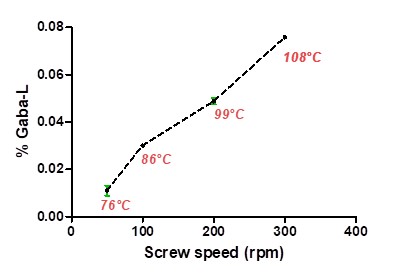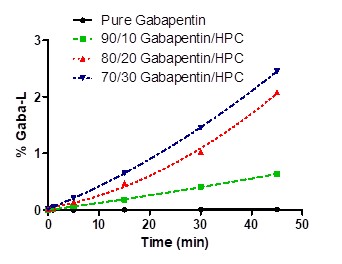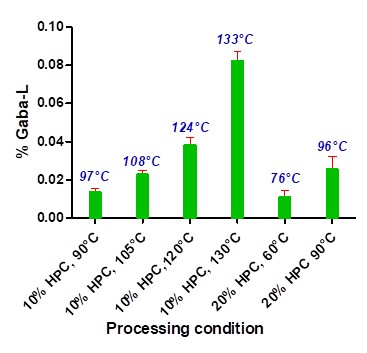Back
Purpose: Twin-screw melt granulation (TSMG) relies on heat and mixing (dispersive and distributive) at the kneading zone for granulation to occur. Compared to roller compaction and wet granulation, TSMG have the following advantages: water and solvent free, more robust process, and more compressible granules. Despite of the short residence time on the order of 10-30 seconds, high thermal and mechanical stresses can potentailly lead to undesired physicochemical changes such as chemical degradation, amorphization, and crystal form changes. The purpose of this study is to investigate how to maintain drug stabilities during twin-screw melt granulation.
Methods: Klucel™ (hydroxypropyl cellulose/HPC, EXF) is used as the thermal binder. With superior binding, tableting, and rheological properties, Klucel is an excellent thermal binder for TSMG. Gabapentin (GABA) is used as the model drug. GABA is high-dose and poorly compressible drug. GABA melts at 165 °C and degrades into Gaba-Lactam (Gaba-L) immediately upon melting. Gaba-Lactam content of GABA granules is quantified using a reversed phase HPLC method. For impurity analysis, a high nominal concentration of GABA (5 mg/mL) is needed to achieve good sensitivity. The quantitation limit of the current method is 0.01%., GABA and HPC blends were subjected to different temperatures for various durations using differential scanning calorimeter to simulate thermal stresses experienced in the extruder. The granulation was carried out using a Leistritz Micro-18 twin-screw co-rotating extruder with a 25 L/D barrel configuration having a 20 mm kneading block (5 mm disc width elements staggered at 30°). Barrel temperature was varied from 60 °C-130 °C. Granule temperature was measured at discharge. Tabletability of granules was measured using a single station tablet press.
Results: The initial granulation runs conducted at 20% HPC level required a minimum barrel temperature of 60 °C to maintain robust granulation process. At 60 °C barrel temperature, granulation was carried out at various screw speed (50 to 300 rpm) and feed rate (1 to 5 kg/hr.). In general, GABA was more stable at lower screw speed and low feed rate. Gaba-L content of these granules correlated well with the temperature (ranging from 76 to 130 °C) of granules at the discharge. Gaba-L content decreased with the decrease in the screw speed at a constant feed rate of 2.5 kg/hr. (Figure 1). The total impurity generated was 0.011% at the lowest screw speed of 50 rpm. The target tensile stress (2 MPa) of tablet was readily achieved for granules under all these processing conditions. Based on the DSC-based thermal stability testing of GABA and HPC physical mixtures, higher HPC content led to greater degradation (Figure 2). Higher degradation could be attributed to the increased crystal defects for gabapentin in presence of HPC when exposed to thermal stresses. This formed the rationale to evaluate lower HPC level (10%) for granulation. Non-linear regression analysis indicated the data fit a second-order polynomial equation (R²>0.96) and further evaluation can be done to elucidate whether the degradation kinetics follow the Prout Tompkins autocatalytic kinetic model reported. When HPC level was lowered to 10%, the minimal barrel temperature required was 90°C. Below this temperature, the extrusion torque fluctuated too much due to the insufficient lubrication by the thermal binder at the barrel surface. As shown in Figure 3, Gaba-L content (0.014%) did not increase despite of higher barrel temperature for granules containing 10% HPC. Even at a barrel temperature of 130 °C, Gaba-L content was at 0.091%.
Conclusion: Our study has demonstrated that it is feasible to melt granulate a thermally labile drug using TSMG process with Klucel as a thermal binder. To minimize drug degradation, we can lower the barrel temperature and more importantly process at a low screw speed. Low screw speed not only reduces the specific mechanical energy, but also more importantly minimizes the temperature in the peak-shear regions of the kneading element. DSC can be used to simulate thermal stresses during TSMG and the results can be applied to guide the TSMG process design. Design of TSMG process can be further improved with a good understanding of the interactions between rheological properties of the formulation, mechanical stresses, and frictional heat dissipation.
References: 1. Kittikunakorn N, Paul S, Koleng III JJ, Liu T, Cook R, Yang F, et al. How Does the Dissimilarity of Screw Geometry Impact Twin-screw Melt Granulation? European Journal of Pharmaceutical Sciences. 2021;157:105645.
2. Zong Z, Qiu J, Tinmanee R, Kirsch LE. Kinetic model for solid-state degradation of gabapentin. Journal of pharmaceutical sciences. 2012;101(6):2123-33.

Figure 1. % Gaba-L as a function of screw speed (rpm) for granules processed with 20% HPC at 60 °C and feed rate of 2.5 kg/hr. Temperatures in red are the granule temperature measured at discharge.

Figure 2. Degradation kinetics of gabapentin observed at 120 °C for different isothermal time using DSC.

Figure 3. % Gaba-L at different processing conditions with 10 and 20% HPC level at screw speed of 50 rpm. Temperatures in blue are the granule temperatures measured at discharge.
Formulation and Delivery - Chemical - Formulation
Category: Late Breaking Poster Abstract
(T1230-07-41) How to Maintain Drug Stability During Twin-Screw Melt Granulation
Tuesday, October 18, 2022
12:30 PM – 1:30 PM ET
- AP
Adwait Pradhan
University of Texas at Austin
Austin, Texas, United States - AP
Adwait Pradhan
University of Texas at Austin
Austin, Texas, United States
Presenting Author(s)
Main Author(s)
Purpose: Twin-screw melt granulation (TSMG) relies on heat and mixing (dispersive and distributive) at the kneading zone for granulation to occur. Compared to roller compaction and wet granulation, TSMG have the following advantages: water and solvent free, more robust process, and more compressible granules. Despite of the short residence time on the order of 10-30 seconds, high thermal and mechanical stresses can potentailly lead to undesired physicochemical changes such as chemical degradation, amorphization, and crystal form changes. The purpose of this study is to investigate how to maintain drug stabilities during twin-screw melt granulation.
Methods: Klucel™ (hydroxypropyl cellulose/HPC, EXF) is used as the thermal binder. With superior binding, tableting, and rheological properties, Klucel is an excellent thermal binder for TSMG. Gabapentin (GABA) is used as the model drug. GABA is high-dose and poorly compressible drug. GABA melts at 165 °C and degrades into Gaba-Lactam (Gaba-L) immediately upon melting. Gaba-Lactam content of GABA granules is quantified using a reversed phase HPLC method. For impurity analysis, a high nominal concentration of GABA (5 mg/mL) is needed to achieve good sensitivity. The quantitation limit of the current method is 0.01%., GABA and HPC blends were subjected to different temperatures for various durations using differential scanning calorimeter to simulate thermal stresses experienced in the extruder. The granulation was carried out using a Leistritz Micro-18 twin-screw co-rotating extruder with a 25 L/D barrel configuration having a 20 mm kneading block (5 mm disc width elements staggered at 30°). Barrel temperature was varied from 60 °C-130 °C. Granule temperature was measured at discharge. Tabletability of granules was measured using a single station tablet press.
Results: The initial granulation runs conducted at 20% HPC level required a minimum barrel temperature of 60 °C to maintain robust granulation process. At 60 °C barrel temperature, granulation was carried out at various screw speed (50 to 300 rpm) and feed rate (1 to 5 kg/hr.). In general, GABA was more stable at lower screw speed and low feed rate. Gaba-L content of these granules correlated well with the temperature (ranging from 76 to 130 °C) of granules at the discharge. Gaba-L content decreased with the decrease in the screw speed at a constant feed rate of 2.5 kg/hr. (Figure 1). The total impurity generated was 0.011% at the lowest screw speed of 50 rpm. The target tensile stress (2 MPa) of tablet was readily achieved for granules under all these processing conditions. Based on the DSC-based thermal stability testing of GABA and HPC physical mixtures, higher HPC content led to greater degradation (Figure 2). Higher degradation could be attributed to the increased crystal defects for gabapentin in presence of HPC when exposed to thermal stresses. This formed the rationale to evaluate lower HPC level (10%) for granulation. Non-linear regression analysis indicated the data fit a second-order polynomial equation (R²>0.96) and further evaluation can be done to elucidate whether the degradation kinetics follow the Prout Tompkins autocatalytic kinetic model reported. When HPC level was lowered to 10%, the minimal barrel temperature required was 90°C. Below this temperature, the extrusion torque fluctuated too much due to the insufficient lubrication by the thermal binder at the barrel surface. As shown in Figure 3, Gaba-L content (0.014%) did not increase despite of higher barrel temperature for granules containing 10% HPC. Even at a barrel temperature of 130 °C, Gaba-L content was at 0.091%.
Conclusion: Our study has demonstrated that it is feasible to melt granulate a thermally labile drug using TSMG process with Klucel as a thermal binder. To minimize drug degradation, we can lower the barrel temperature and more importantly process at a low screw speed. Low screw speed not only reduces the specific mechanical energy, but also more importantly minimizes the temperature in the peak-shear regions of the kneading element. DSC can be used to simulate thermal stresses during TSMG and the results can be applied to guide the TSMG process design. Design of TSMG process can be further improved with a good understanding of the interactions between rheological properties of the formulation, mechanical stresses, and frictional heat dissipation.
References: 1. Kittikunakorn N, Paul S, Koleng III JJ, Liu T, Cook R, Yang F, et al. How Does the Dissimilarity of Screw Geometry Impact Twin-screw Melt Granulation? European Journal of Pharmaceutical Sciences. 2021;157:105645.
2. Zong Z, Qiu J, Tinmanee R, Kirsch LE. Kinetic model for solid-state degradation of gabapentin. Journal of pharmaceutical sciences. 2012;101(6):2123-33.

Figure 1. % Gaba-L as a function of screw speed (rpm) for granules processed with 20% HPC at 60 °C and feed rate of 2.5 kg/hr. Temperatures in red are the granule temperature measured at discharge.

Figure 2. Degradation kinetics of gabapentin observed at 120 °C for different isothermal time using DSC.

Figure 3. % Gaba-L at different processing conditions with 10 and 20% HPC level at screw speed of 50 rpm. Temperatures in blue are the granule temperatures measured at discharge.
